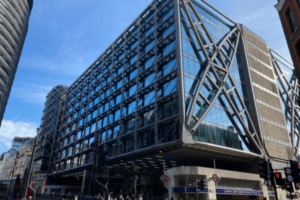In virus-free times you can visit three Roman sites within the City: the Amphitheatre underneath Guildhall Art Gallery, the baths on Lower Thames Street, and the Mithraeum in the Bloomberg Building. Each is definitely worth a visit, and the three are very different, not only in terms of the buildings’ original purpose, but also as visitor experiences.
The most high-tech is the Mithraeum. The construction of Bloomberg’s new European headquarters allowed for an extensive archaeological dig and the repositioning of the remains of the temple. These had been found when an earlier building, Bucklersbury House, was put up in 1954. The temple was then reassembled rather unsympathetically on the pavement outside the office block. It has been moved back to its original site on the Walbrook in an underground room which is filled with tiny droplets of water onto which reconstructed pillars are projected to give an idea of look of the original interior.
During the construction of the Bloomberg building, excavators were able to investigate the foundations of the temple that surprisingly had not been destroyed in 1954. Consequently, the reconstructed and moved monument is now more complete. The Walbrook was incredibly rich archaeologically, but much of this was destroyed when Bucklersbury House went up. Back then, there were no requirements for surveys and digs paid for by contractors. The devastation caused by the 1950s construction was a major catalyst for getting protections put in place for modern developments in the City. Enough remained in the area, though, for the dig at the Bloomberg site to unearth some impressive finds, including a large number of writing tablets.
The Mithraeum dates to around 240 AD. The cult of Mithras was an import from Persia and spread throughout the empire. Its members were exclusively male and had to pass through a series of rigorous initiation rites. There were seven grades, and as a consequence congregations remained limited, and the chapels of the cult are all small. They were built deep in the earth, which probably had a ritual significance and helped maintain the secrecy of the initiation rites.
The beliefs of the cult remain elusive, but Mithras was some kind of redemptive figure. The focal point of the chapels was the Tauroctonos, a carving showing him slaughtering a bull. Many of the cult members were soldiers, junior-ranking staff of the imperial administration, and businessmen.
At the London site, in addition to Mithraic sculptures, other gods were found in 1954, which can now be seen in the Museum of London. These included a river-god, perhaps the Thames, Serapis and Minerva, illustrating an acceptance of other cults. This ‘toleration’ put the religion in line with other cults in the Roman empire, which did not demand exclusive devotion to their gods. Together with the small size of the congregations this helped Mithraism avoid arousing the ire of the government, unlike another import from the East. Christianity was both exclusive and put a great deal of emphasis on winning converts.
The temple underwent extensive rebuilding in the early fourth century, which included the removal of its internal columns. One recent interpretation of this, is that it was repurposed as a temple of Bacchus. However, the evidence remains unclear, as another interpretation has Mithras and Bacchus being worshipped together in the temple, before the remodelling. The temple was gradually abandoned in the fourth century. It is again unclear how, or if the rise of Christianity was related to this decline – evidence for development of the new religion in Britain is extremely thin in general. However, the lack of robbing of the stone at the Mithraeum suggests it that it fell into being a ruin, rather than falling victim to the anger of Christian zealots as some earlier theories had it.
The Mithraeum is currently closed due to Covid-19. When life gets back to normal you can obtain free timed-tickets from the website: www.londonmithraeum.com.
–
Related Blog Posts:
The Roman London Wall and why it was built
Leadenhall Market – the Heart of Roman London
–
Explore more of Roman London. Book tickets for Ian McDiarmid’s Roman London Walk now. Private tour also available here.


